Recruitment & Selection Fundamentals Report - HRESS2202 at BVC
VerifiedAdded on 2023/06/11
|11
|2164
|328
Report
AI Summary
This report provides a comprehensive overview of the fundamentals of recruitment and selection, covering key aspects such as organizational strategy, talent management, employee engagement, legal considerations, and job analysis. It highlights the importance of aligning organizational strategy with recruitment and selection processes, discussing the advantages and consequences of alignment and non-alignment. The report also distinguishes between talent management and employee engagement, recruitment and selection, and explores the impact of hiring practices on employee engagement. Furthermore, it delves into legal considerations in recruitment and selection, including employer obligations, provincial and federal perspectives on HR legislation, and the importance of legally defensible hiring decisions. The report also examines job analysis methods and their significance in recruitment and selection, along with ensuring the legal defensibility of the job analysis process. Finally, it presents a job analysis for a marketing manager role, including required knowledge, skills, abilities, and work context, while also discussing the advantages and disadvantages of using NOC and O*NET. This resource is available on Desklib, where students can find a wealth of study materials, including past papers and solved assignments.
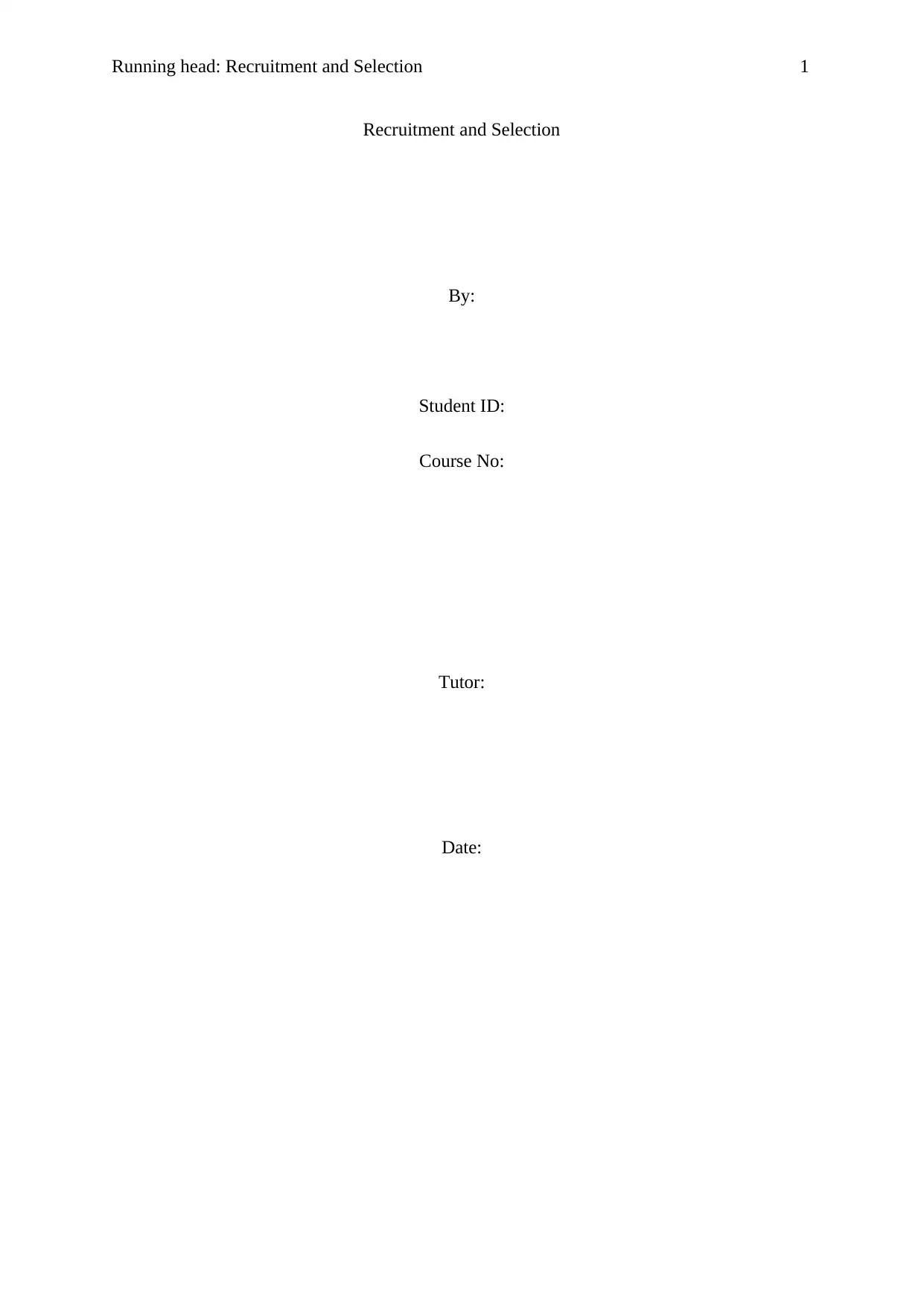
Running head: Recruitment and Selection 1
Recruitment and Selection
By:
Student ID:
Course No:
Tutor:
Date:
Recruitment and Selection
By:
Student ID:
Course No:
Tutor:
Date:
Paraphrase This Document
Need a fresh take? Get an instant paraphrase of this document with our AI Paraphraser
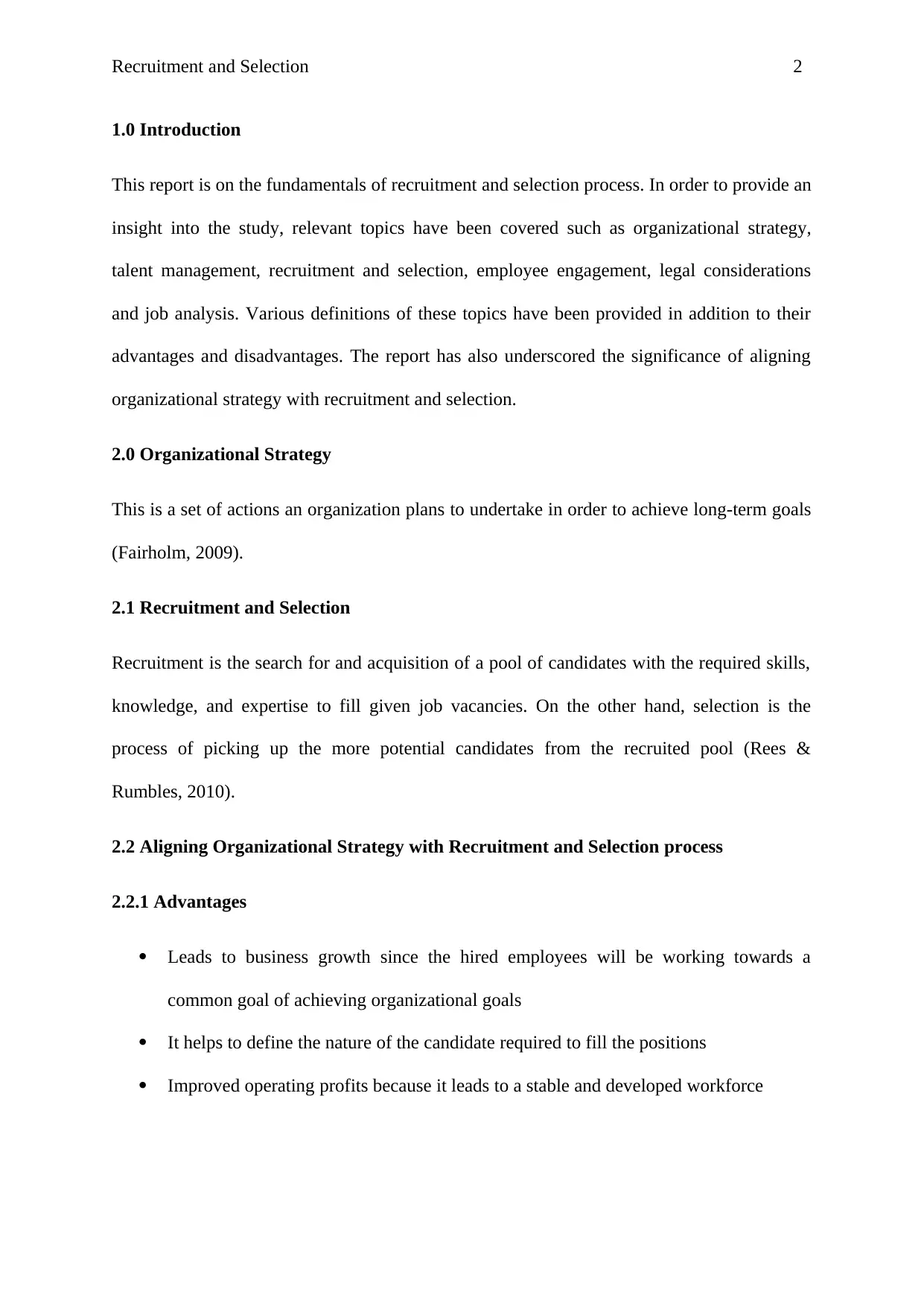
Recruitment and Selection 2
1.0 Introduction
This report is on the fundamentals of recruitment and selection process. In order to provide an
insight into the study, relevant topics have been covered such as organizational strategy,
talent management, recruitment and selection, employee engagement, legal considerations
and job analysis. Various definitions of these topics have been provided in addition to their
advantages and disadvantages. The report has also underscored the significance of aligning
organizational strategy with recruitment and selection.
2.0 Organizational Strategy
This is a set of actions an organization plans to undertake in order to achieve long-term goals
(Fairholm, 2009).
2.1 Recruitment and Selection
Recruitment is the search for and acquisition of a pool of candidates with the required skills,
knowledge, and expertise to fill given job vacancies. On the other hand, selection is the
process of picking up the more potential candidates from the recruited pool (Rees &
Rumbles, 2010).
2.2 Aligning Organizational Strategy with Recruitment and Selection process
2.2.1 Advantages
Leads to business growth since the hired employees will be working towards a
common goal of achieving organizational goals
It helps to define the nature of the candidate required to fill the positions
Improved operating profits because it leads to a stable and developed workforce
1.0 Introduction
This report is on the fundamentals of recruitment and selection process. In order to provide an
insight into the study, relevant topics have been covered such as organizational strategy,
talent management, recruitment and selection, employee engagement, legal considerations
and job analysis. Various definitions of these topics have been provided in addition to their
advantages and disadvantages. The report has also underscored the significance of aligning
organizational strategy with recruitment and selection.
2.0 Organizational Strategy
This is a set of actions an organization plans to undertake in order to achieve long-term goals
(Fairholm, 2009).
2.1 Recruitment and Selection
Recruitment is the search for and acquisition of a pool of candidates with the required skills,
knowledge, and expertise to fill given job vacancies. On the other hand, selection is the
process of picking up the more potential candidates from the recruited pool (Rees &
Rumbles, 2010).
2.2 Aligning Organizational Strategy with Recruitment and Selection process
2.2.1 Advantages
Leads to business growth since the hired employees will be working towards a
common goal of achieving organizational goals
It helps to define the nature of the candidate required to fill the positions
Improved operating profits because it leads to a stable and developed workforce
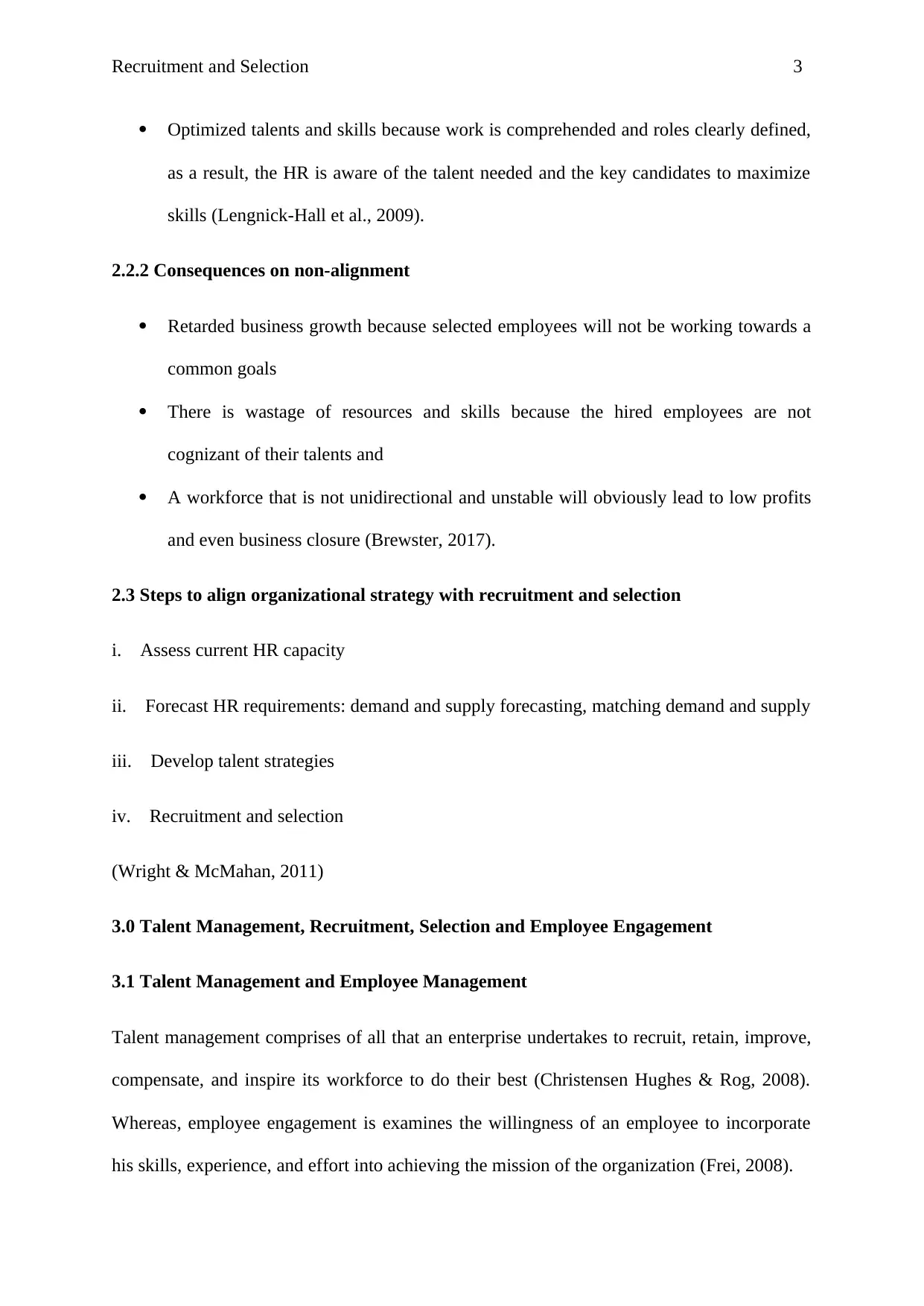
Recruitment and Selection 3
Optimized talents and skills because work is comprehended and roles clearly defined,
as a result, the HR is aware of the talent needed and the key candidates to maximize
skills (Lengnick-Hall et al., 2009).
2.2.2 Consequences on non-alignment
Retarded business growth because selected employees will not be working towards a
common goals
There is wastage of resources and skills because the hired employees are not
cognizant of their talents and
A workforce that is not unidirectional and unstable will obviously lead to low profits
and even business closure (Brewster, 2017).
2.3 Steps to align organizational strategy with recruitment and selection
i. Assess current HR capacity
ii. Forecast HR requirements: demand and supply forecasting, matching demand and supply
iii. Develop talent strategies
iv. Recruitment and selection
(Wright & McMahan, 2011)
3.0 Talent Management, Recruitment, Selection and Employee Engagement
3.1 Talent Management and Employee Management
Talent management comprises of all that an enterprise undertakes to recruit, retain, improve,
compensate, and inspire its workforce to do their best (Christensen Hughes & Rog, 2008).
Whereas, employee engagement is examines the willingness of an employee to incorporate
his skills, experience, and effort into achieving the mission of the organization (Frei, 2008).
Optimized talents and skills because work is comprehended and roles clearly defined,
as a result, the HR is aware of the talent needed and the key candidates to maximize
skills (Lengnick-Hall et al., 2009).
2.2.2 Consequences on non-alignment
Retarded business growth because selected employees will not be working towards a
common goals
There is wastage of resources and skills because the hired employees are not
cognizant of their talents and
A workforce that is not unidirectional and unstable will obviously lead to low profits
and even business closure (Brewster, 2017).
2.3 Steps to align organizational strategy with recruitment and selection
i. Assess current HR capacity
ii. Forecast HR requirements: demand and supply forecasting, matching demand and supply
iii. Develop talent strategies
iv. Recruitment and selection
(Wright & McMahan, 2011)
3.0 Talent Management, Recruitment, Selection and Employee Engagement
3.1 Talent Management and Employee Management
Talent management comprises of all that an enterprise undertakes to recruit, retain, improve,
compensate, and inspire its workforce to do their best (Christensen Hughes & Rog, 2008).
Whereas, employee engagement is examines the willingness of an employee to incorporate
his skills, experience, and effort into achieving the mission of the organization (Frei, 2008).
⊘ This is a preview!⊘
Do you want full access?
Subscribe today to unlock all pages.

Trusted by 1+ million students worldwide
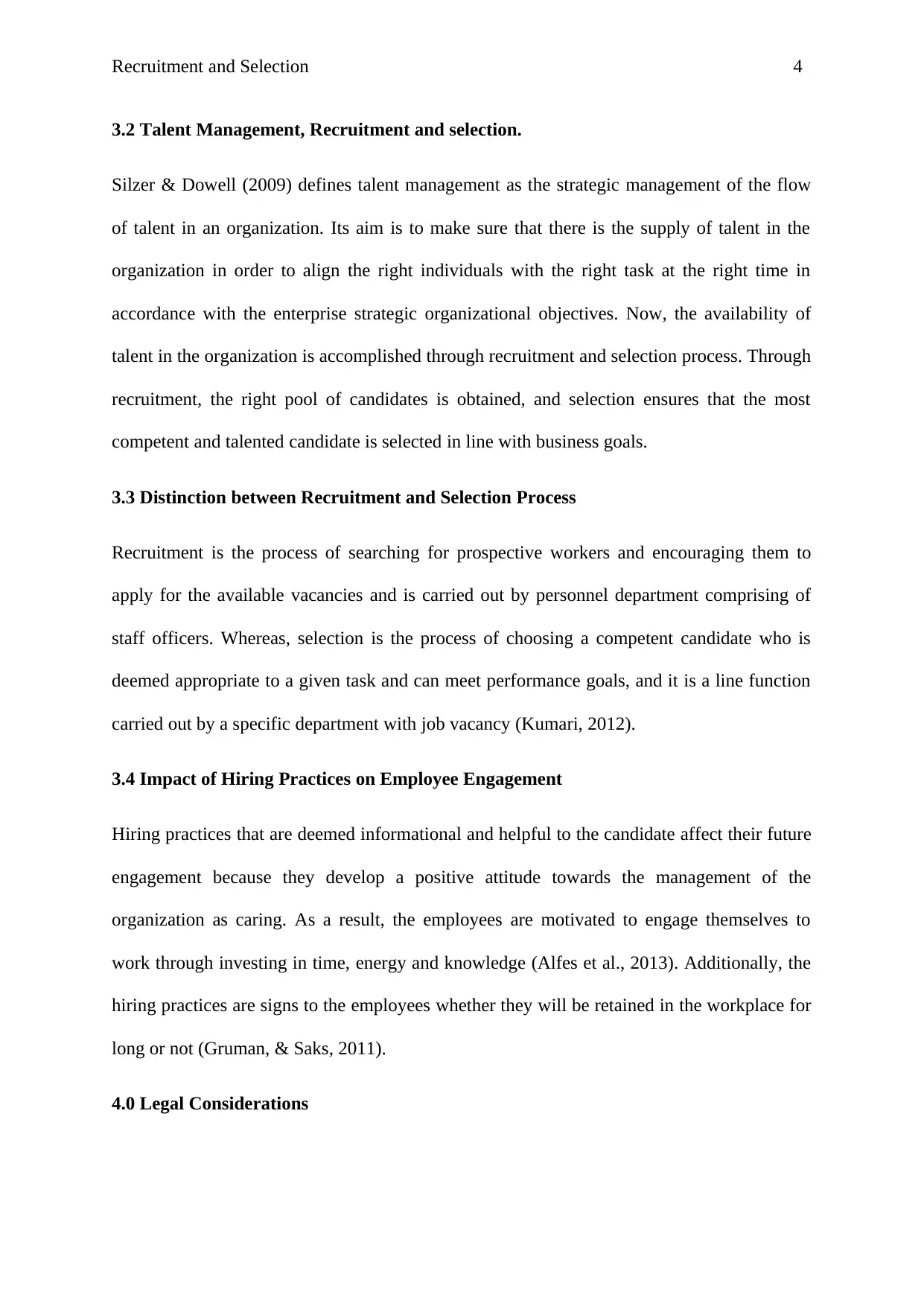
Recruitment and Selection 4
3.2 Talent Management, Recruitment and selection.
Silzer & Dowell (2009) defines talent management as the strategic management of the flow
of talent in an organization. Its aim is to make sure that there is the supply of talent in the
organization in order to align the right individuals with the right task at the right time in
accordance with the enterprise strategic organizational objectives. Now, the availability of
talent in the organization is accomplished through recruitment and selection process. Through
recruitment, the right pool of candidates is obtained, and selection ensures that the most
competent and talented candidate is selected in line with business goals.
3.3 Distinction between Recruitment and Selection Process
Recruitment is the process of searching for prospective workers and encouraging them to
apply for the available vacancies and is carried out by personnel department comprising of
staff officers. Whereas, selection is the process of choosing a competent candidate who is
deemed appropriate to a given task and can meet performance goals, and it is a line function
carried out by a specific department with job vacancy (Kumari, 2012).
3.4 Impact of Hiring Practices on Employee Engagement
Hiring practices that are deemed informational and helpful to the candidate affect their future
engagement because they develop a positive attitude towards the management of the
organization as caring. As a result, the employees are motivated to engage themselves to
work through investing in time, energy and knowledge (Alfes et al., 2013). Additionally, the
hiring practices are signs to the employees whether they will be retained in the workplace for
long or not (Gruman, & Saks, 2011).
4.0 Legal Considerations
3.2 Talent Management, Recruitment and selection.
Silzer & Dowell (2009) defines talent management as the strategic management of the flow
of talent in an organization. Its aim is to make sure that there is the supply of talent in the
organization in order to align the right individuals with the right task at the right time in
accordance with the enterprise strategic organizational objectives. Now, the availability of
talent in the organization is accomplished through recruitment and selection process. Through
recruitment, the right pool of candidates is obtained, and selection ensures that the most
competent and talented candidate is selected in line with business goals.
3.3 Distinction between Recruitment and Selection Process
Recruitment is the process of searching for prospective workers and encouraging them to
apply for the available vacancies and is carried out by personnel department comprising of
staff officers. Whereas, selection is the process of choosing a competent candidate who is
deemed appropriate to a given task and can meet performance goals, and it is a line function
carried out by a specific department with job vacancy (Kumari, 2012).
3.4 Impact of Hiring Practices on Employee Engagement
Hiring practices that are deemed informational and helpful to the candidate affect their future
engagement because they develop a positive attitude towards the management of the
organization as caring. As a result, the employees are motivated to engage themselves to
work through investing in time, energy and knowledge (Alfes et al., 2013). Additionally, the
hiring practices are signs to the employees whether they will be retained in the workplace for
long or not (Gruman, & Saks, 2011).
4.0 Legal Considerations
Paraphrase This Document
Need a fresh take? Get an instant paraphrase of this document with our AI Paraphraser
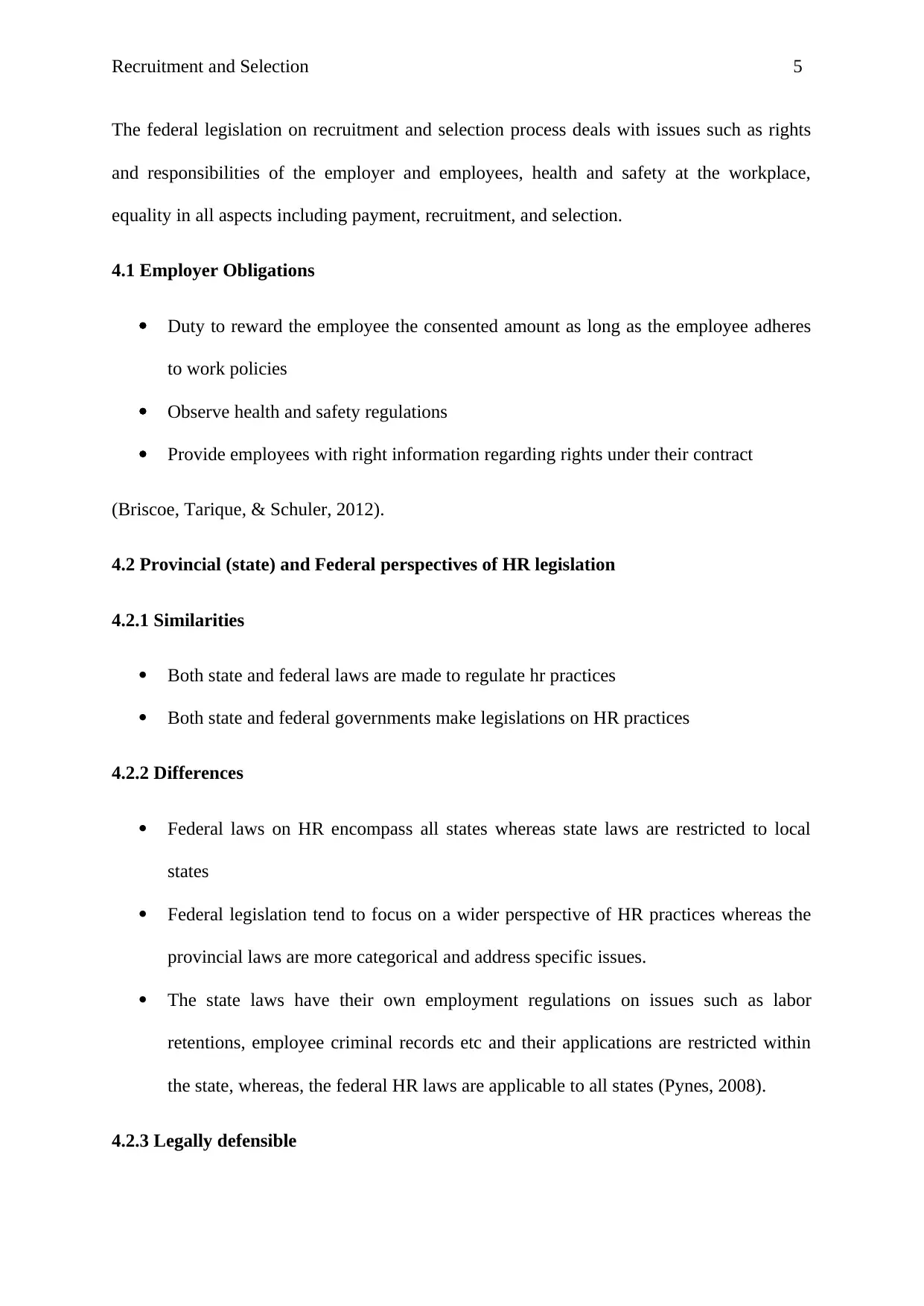
Recruitment and Selection 5
The federal legislation on recruitment and selection process deals with issues such as rights
and responsibilities of the employer and employees, health and safety at the workplace,
equality in all aspects including payment, recruitment, and selection.
4.1 Employer Obligations
Duty to reward the employee the consented amount as long as the employee adheres
to work policies
Observe health and safety regulations
Provide employees with right information regarding rights under their contract
(Briscoe, Tarique, & Schuler, 2012).
4.2 Provincial (state) and Federal perspectives of HR legislation
4.2.1 Similarities
Both state and federal laws are made to regulate hr practices
Both state and federal governments make legislations on HR practices
4.2.2 Differences
Federal laws on HR encompass all states whereas state laws are restricted to local
states
Federal legislation tend to focus on a wider perspective of HR practices whereas the
provincial laws are more categorical and address specific issues.
The state laws have their own employment regulations on issues such as labor
retentions, employee criminal records etc and their applications are restricted within
the state, whereas, the federal HR laws are applicable to all states (Pynes, 2008).
4.2.3 Legally defensible
The federal legislation on recruitment and selection process deals with issues such as rights
and responsibilities of the employer and employees, health and safety at the workplace,
equality in all aspects including payment, recruitment, and selection.
4.1 Employer Obligations
Duty to reward the employee the consented amount as long as the employee adheres
to work policies
Observe health and safety regulations
Provide employees with right information regarding rights under their contract
(Briscoe, Tarique, & Schuler, 2012).
4.2 Provincial (state) and Federal perspectives of HR legislation
4.2.1 Similarities
Both state and federal laws are made to regulate hr practices
Both state and federal governments make legislations on HR practices
4.2.2 Differences
Federal laws on HR encompass all states whereas state laws are restricted to local
states
Federal legislation tend to focus on a wider perspective of HR practices whereas the
provincial laws are more categorical and address specific issues.
The state laws have their own employment regulations on issues such as labor
retentions, employee criminal records etc and their applications are restricted within
the state, whereas, the federal HR laws are applicable to all states (Pynes, 2008).
4.2.3 Legally defensible
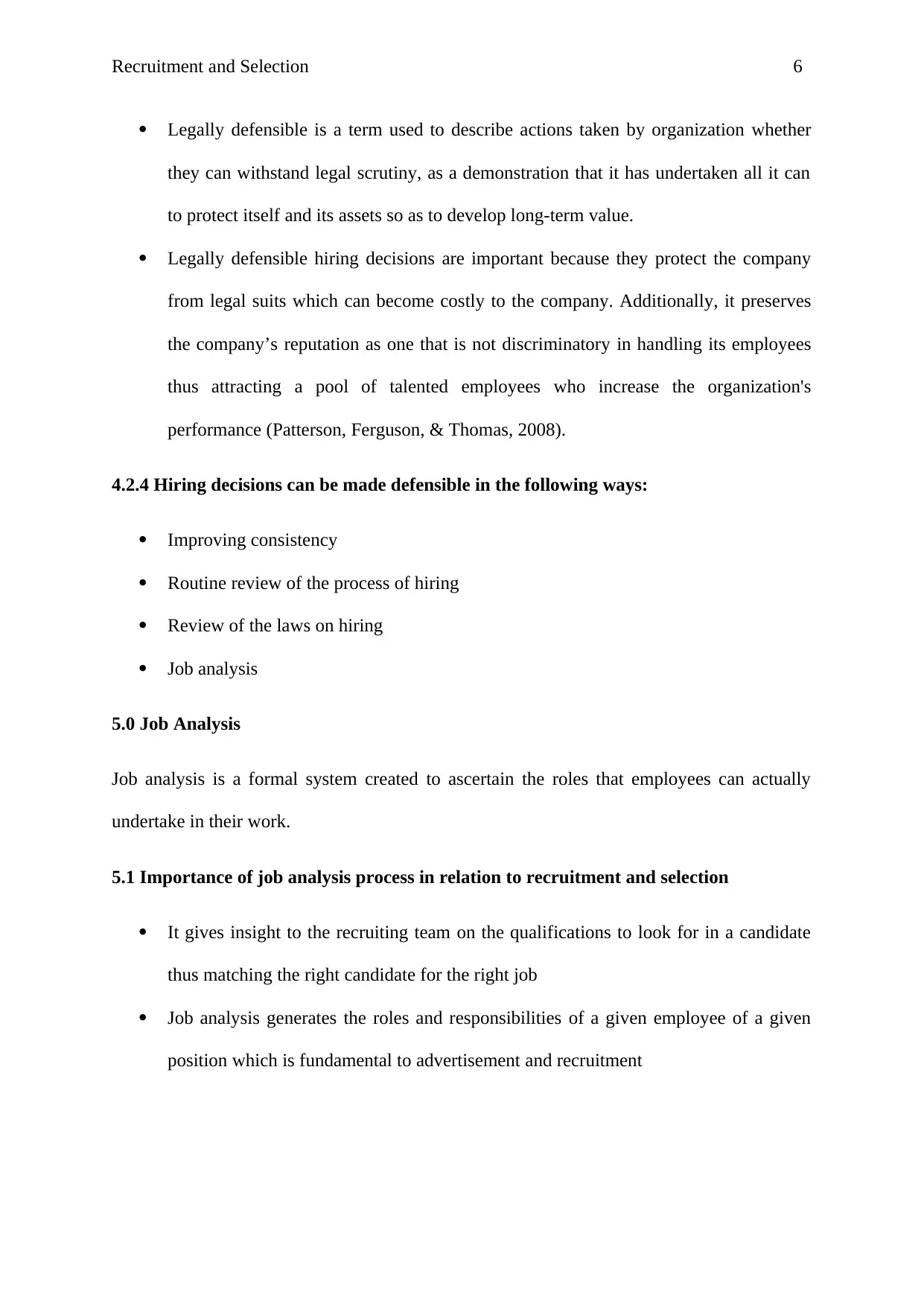
Recruitment and Selection 6
Legally defensible is a term used to describe actions taken by organization whether
they can withstand legal scrutiny, as a demonstration that it has undertaken all it can
to protect itself and its assets so as to develop long-term value.
Legally defensible hiring decisions are important because they protect the company
from legal suits which can become costly to the company. Additionally, it preserves
the company’s reputation as one that is not discriminatory in handling its employees
thus attracting a pool of talented employees who increase the organization's
performance (Patterson, Ferguson, & Thomas, 2008).
4.2.4 Hiring decisions can be made defensible in the following ways:
Improving consistency
Routine review of the process of hiring
Review of the laws on hiring
Job analysis
5.0 Job Analysis
Job analysis is a formal system created to ascertain the roles that employees can actually
undertake in their work.
5.1 Importance of job analysis process in relation to recruitment and selection
It gives insight to the recruiting team on the qualifications to look for in a candidate
thus matching the right candidate for the right job
Job analysis generates the roles and responsibilities of a given employee of a given
position which is fundamental to advertisement and recruitment
Legally defensible is a term used to describe actions taken by organization whether
they can withstand legal scrutiny, as a demonstration that it has undertaken all it can
to protect itself and its assets so as to develop long-term value.
Legally defensible hiring decisions are important because they protect the company
from legal suits which can become costly to the company. Additionally, it preserves
the company’s reputation as one that is not discriminatory in handling its employees
thus attracting a pool of talented employees who increase the organization's
performance (Patterson, Ferguson, & Thomas, 2008).
4.2.4 Hiring decisions can be made defensible in the following ways:
Improving consistency
Routine review of the process of hiring
Review of the laws on hiring
Job analysis
5.0 Job Analysis
Job analysis is a formal system created to ascertain the roles that employees can actually
undertake in their work.
5.1 Importance of job analysis process in relation to recruitment and selection
It gives insight to the recruiting team on the qualifications to look for in a candidate
thus matching the right candidate for the right job
Job analysis generates the roles and responsibilities of a given employee of a given
position which is fundamental to advertisement and recruitment
⊘ This is a preview!⊘
Do you want full access?
Subscribe today to unlock all pages.

Trusted by 1+ million students worldwide
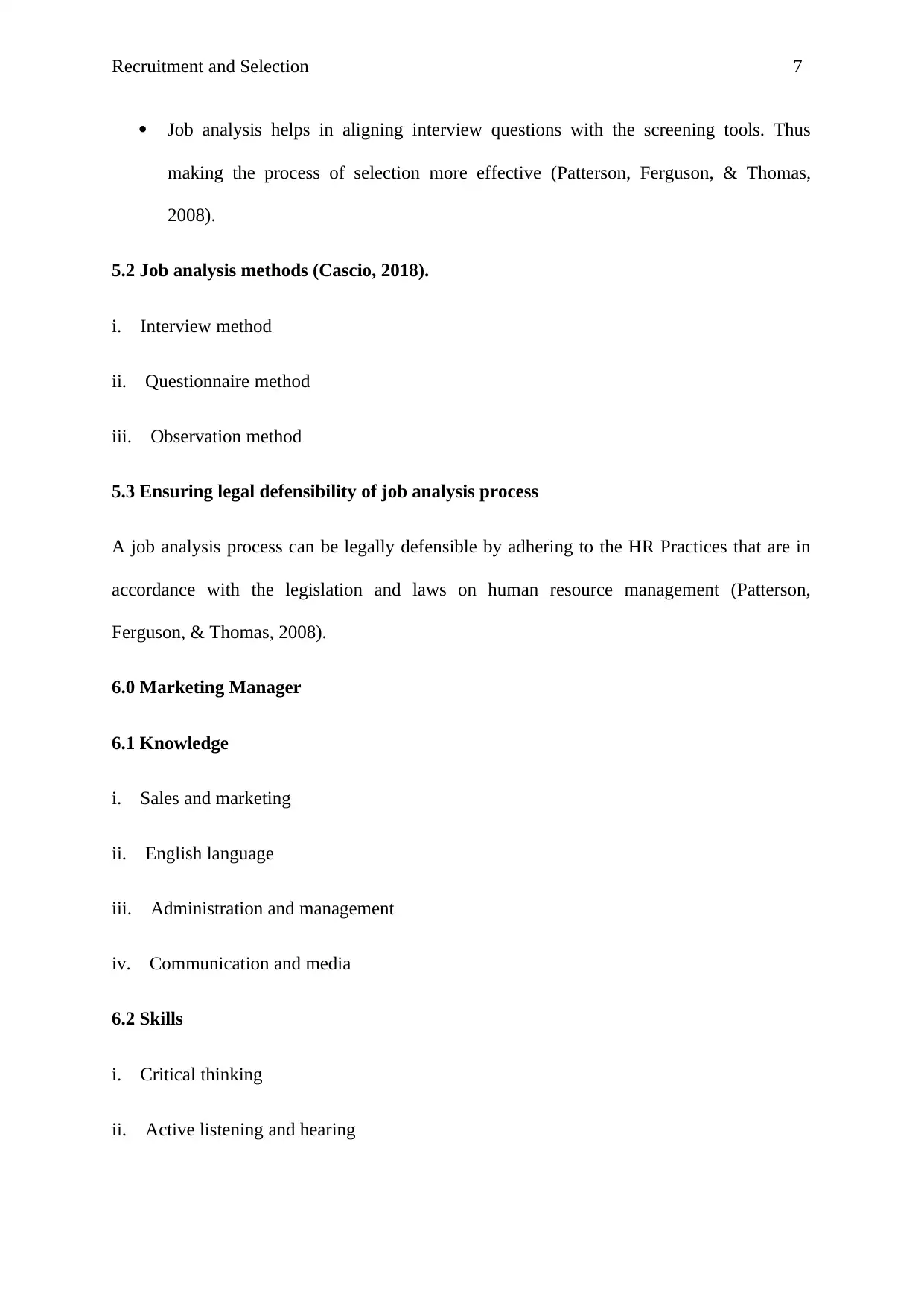
Recruitment and Selection 7
Job analysis helps in aligning interview questions with the screening tools. Thus
making the process of selection more effective (Patterson, Ferguson, & Thomas,
2008).
5.2 Job analysis methods (Cascio, 2018).
i. Interview method
ii. Questionnaire method
iii. Observation method
5.3 Ensuring legal defensibility of job analysis process
A job analysis process can be legally defensible by adhering to the HR Practices that are in
accordance with the legislation and laws on human resource management (Patterson,
Ferguson, & Thomas, 2008).
6.0 Marketing Manager
6.1 Knowledge
i. Sales and marketing
ii. English language
iii. Administration and management
iv. Communication and media
6.2 Skills
i. Critical thinking
ii. Active listening and hearing
Job analysis helps in aligning interview questions with the screening tools. Thus
making the process of selection more effective (Patterson, Ferguson, & Thomas,
2008).
5.2 Job analysis methods (Cascio, 2018).
i. Interview method
ii. Questionnaire method
iii. Observation method
5.3 Ensuring legal defensibility of job analysis process
A job analysis process can be legally defensible by adhering to the HR Practices that are in
accordance with the legislation and laws on human resource management (Patterson,
Ferguson, & Thomas, 2008).
6.0 Marketing Manager
6.1 Knowledge
i. Sales and marketing
ii. English language
iii. Administration and management
iv. Communication and media
6.2 Skills
i. Critical thinking
ii. Active listening and hearing
Paraphrase This Document
Need a fresh take? Get an instant paraphrase of this document with our AI Paraphraser
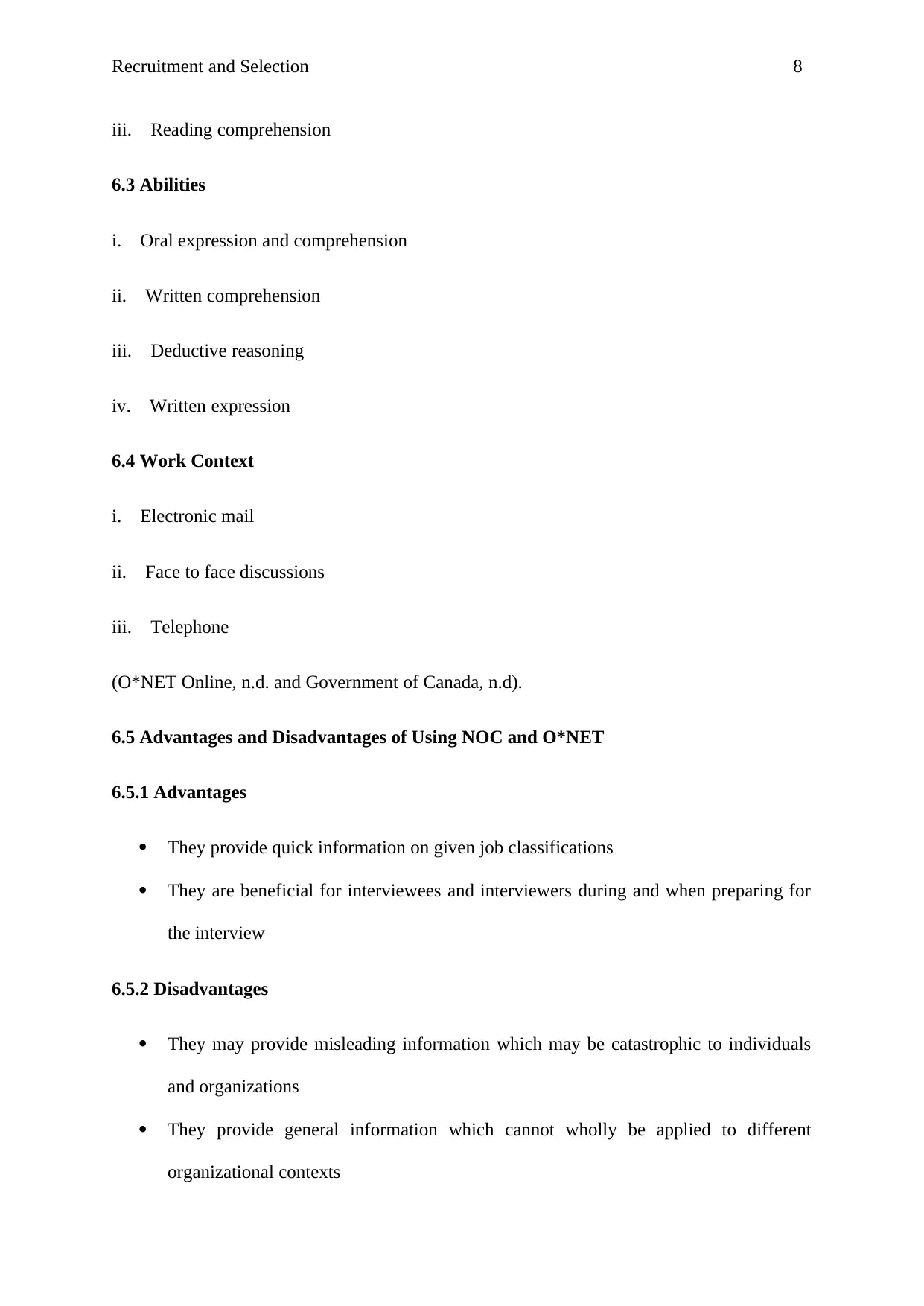
Recruitment and Selection 8
iii. Reading comprehension
6.3 Abilities
i. Oral expression and comprehension
ii. Written comprehension
iii. Deductive reasoning
iv. Written expression
6.4 Work Context
i. Electronic mail
ii. Face to face discussions
iii. Telephone
(O*NET Online, n.d. and Government of Canada, n.d).
6.5 Advantages and Disadvantages of Using NOC and O*NET
6.5.1 Advantages
They provide quick information on given job classifications
They are beneficial for interviewees and interviewers during and when preparing for
the interview
6.5.2 Disadvantages
They may provide misleading information which may be catastrophic to individuals
and organizations
They provide general information which cannot wholly be applied to different
organizational contexts
iii. Reading comprehension
6.3 Abilities
i. Oral expression and comprehension
ii. Written comprehension
iii. Deductive reasoning
iv. Written expression
6.4 Work Context
i. Electronic mail
ii. Face to face discussions
iii. Telephone
(O*NET Online, n.d. and Government of Canada, n.d).
6.5 Advantages and Disadvantages of Using NOC and O*NET
6.5.1 Advantages
They provide quick information on given job classifications
They are beneficial for interviewees and interviewers during and when preparing for
the interview
6.5.2 Disadvantages
They may provide misleading information which may be catastrophic to individuals
and organizations
They provide general information which cannot wholly be applied to different
organizational contexts
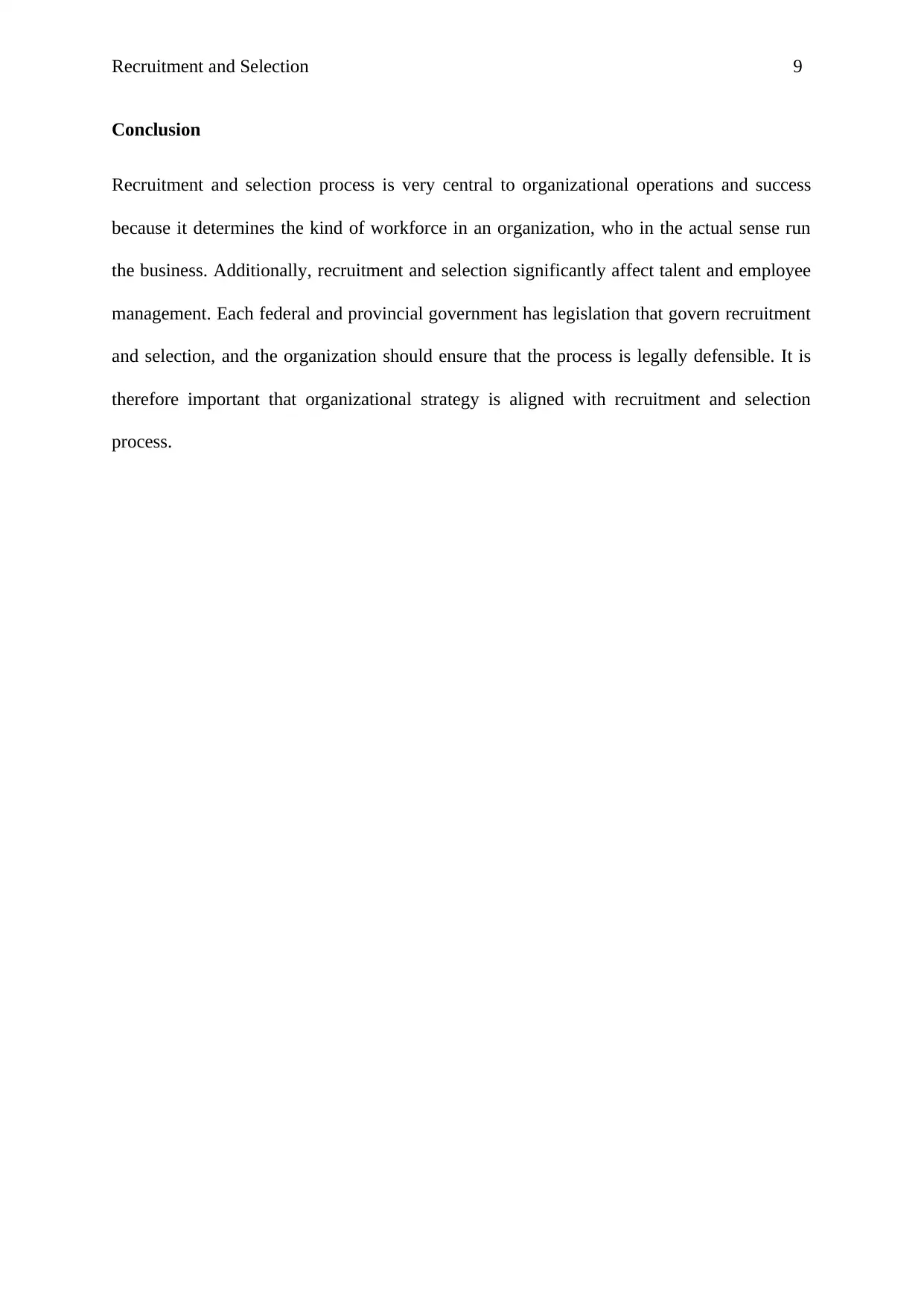
Recruitment and Selection 9
Conclusion
Recruitment and selection process is very central to organizational operations and success
because it determines the kind of workforce in an organization, who in the actual sense run
the business. Additionally, recruitment and selection significantly affect talent and employee
management. Each federal and provincial government has legislation that govern recruitment
and selection, and the organization should ensure that the process is legally defensible. It is
therefore important that organizational strategy is aligned with recruitment and selection
process.
Conclusion
Recruitment and selection process is very central to organizational operations and success
because it determines the kind of workforce in an organization, who in the actual sense run
the business. Additionally, recruitment and selection significantly affect talent and employee
management. Each federal and provincial government has legislation that govern recruitment
and selection, and the organization should ensure that the process is legally defensible. It is
therefore important that organizational strategy is aligned with recruitment and selection
process.
⊘ This is a preview!⊘
Do you want full access?
Subscribe today to unlock all pages.

Trusted by 1+ million students worldwide
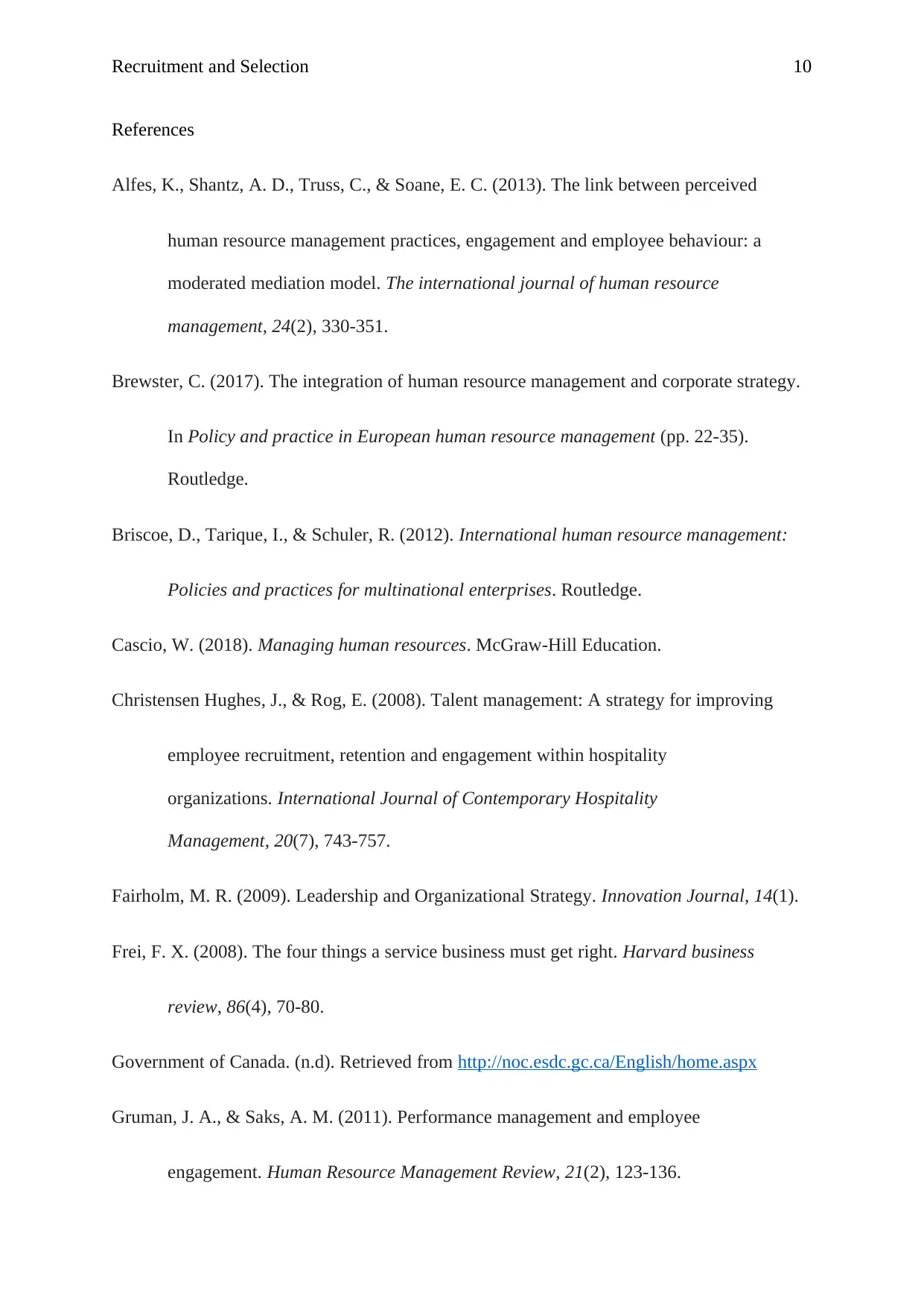
Recruitment and Selection 10
References
Alfes, K., Shantz, A. D., Truss, C., & Soane, E. C. (2013). The link between perceived
human resource management practices, engagement and employee behaviour: a
moderated mediation model. The international journal of human resource
management, 24(2), 330-351.
Brewster, C. (2017). The integration of human resource management and corporate strategy.
In Policy and practice in European human resource management (pp. 22-35).
Routledge.
Briscoe, D., Tarique, I., & Schuler, R. (2012). International human resource management:
Policies and practices for multinational enterprises. Routledge.
Cascio, W. (2018). Managing human resources. McGraw-Hill Education.
Christensen Hughes, J., & Rog, E. (2008). Talent management: A strategy for improving
employee recruitment, retention and engagement within hospitality
organizations. International Journal of Contemporary Hospitality
Management, 20(7), 743-757.
Fairholm, M. R. (2009). Leadership and Organizational Strategy. Innovation Journal, 14(1).
Frei, F. X. (2008). The four things a service business must get right. Harvard business
review, 86(4), 70-80.
Government of Canada. (n.d). Retrieved from http://noc.esdc.gc.ca/English/home.aspx
Gruman, J. A., & Saks, A. M. (2011). Performance management and employee
engagement. Human Resource Management Review, 21(2), 123-136.
References
Alfes, K., Shantz, A. D., Truss, C., & Soane, E. C. (2013). The link between perceived
human resource management practices, engagement and employee behaviour: a
moderated mediation model. The international journal of human resource
management, 24(2), 330-351.
Brewster, C. (2017). The integration of human resource management and corporate strategy.
In Policy and practice in European human resource management (pp. 22-35).
Routledge.
Briscoe, D., Tarique, I., & Schuler, R. (2012). International human resource management:
Policies and practices for multinational enterprises. Routledge.
Cascio, W. (2018). Managing human resources. McGraw-Hill Education.
Christensen Hughes, J., & Rog, E. (2008). Talent management: A strategy for improving
employee recruitment, retention and engagement within hospitality
organizations. International Journal of Contemporary Hospitality
Management, 20(7), 743-757.
Fairholm, M. R. (2009). Leadership and Organizational Strategy. Innovation Journal, 14(1).
Frei, F. X. (2008). The four things a service business must get right. Harvard business
review, 86(4), 70-80.
Government of Canada. (n.d). Retrieved from http://noc.esdc.gc.ca/English/home.aspx
Gruman, J. A., & Saks, A. M. (2011). Performance management and employee
engagement. Human Resource Management Review, 21(2), 123-136.
Paraphrase This Document
Need a fresh take? Get an instant paraphrase of this document with our AI Paraphraser
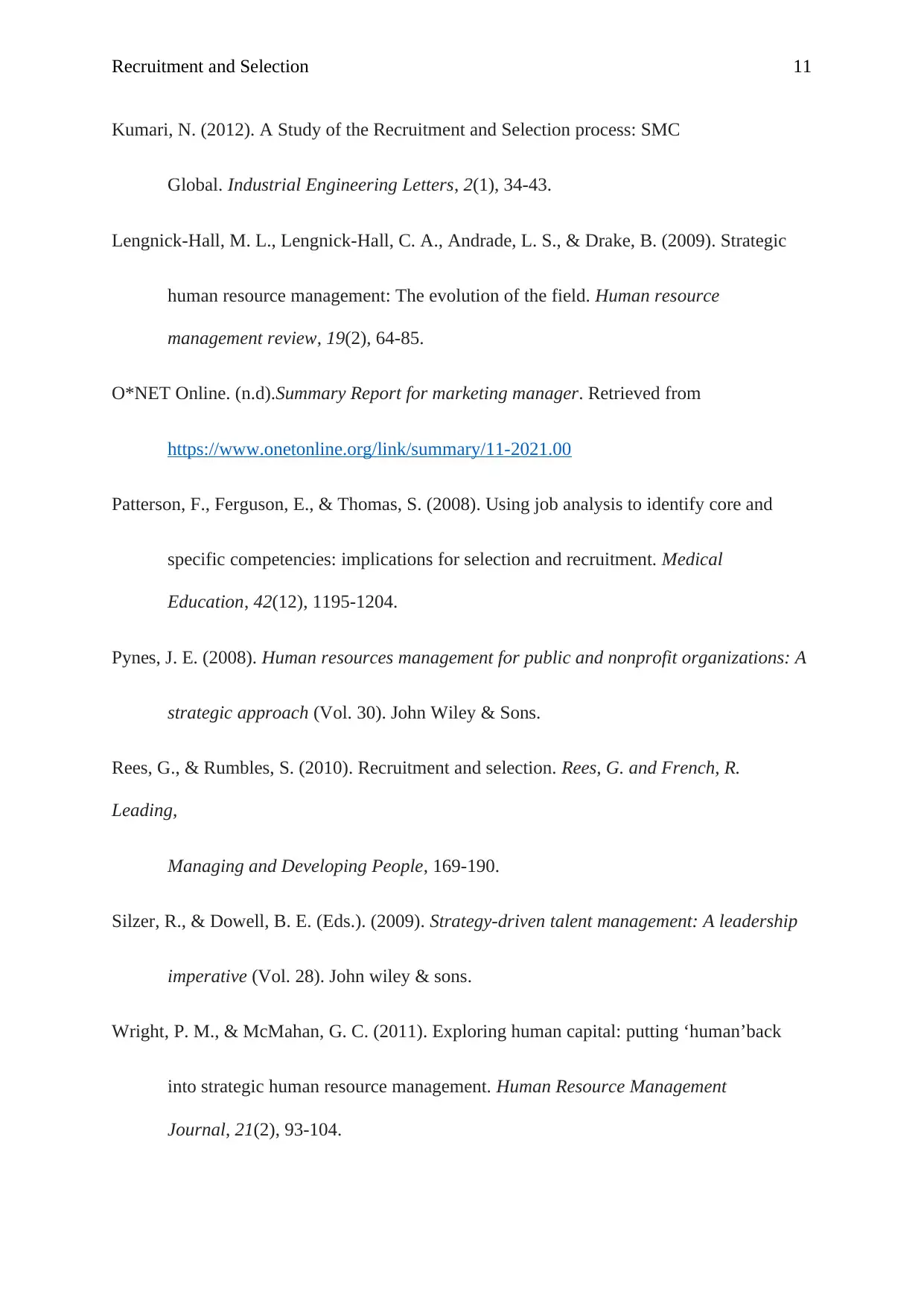
Recruitment and Selection 11
Kumari, N. (2012). A Study of the Recruitment and Selection process: SMC
Global. Industrial Engineering Letters, 2(1), 34-43.
Lengnick-Hall, M. L., Lengnick-Hall, C. A., Andrade, L. S., & Drake, B. (2009). Strategic
human resource management: The evolution of the field. Human resource
management review, 19(2), 64-85.
O*NET Online. (n.d).Summary Report for marketing manager. Retrieved from
https://www.onetonline.org/link/summary/11-2021.00
Patterson, F., Ferguson, E., & Thomas, S. (2008). Using job analysis to identify core and
specific competencies: implications for selection and recruitment. Medical
Education, 42(12), 1195-1204.
Pynes, J. E. (2008). Human resources management for public and nonprofit organizations: A
strategic approach (Vol. 30). John Wiley & Sons.
Rees, G., & Rumbles, S. (2010). Recruitment and selection. Rees, G. and French, R.
Leading,
Managing and Developing People, 169-190.
Silzer, R., & Dowell, B. E. (Eds.). (2009). Strategy-driven talent management: A leadership
imperative (Vol. 28). John wiley & sons.
Wright, P. M., & McMahan, G. C. (2011). Exploring human capital: putting ‘human’back
into strategic human resource management. Human Resource Management
Journal, 21(2), 93-104.
Kumari, N. (2012). A Study of the Recruitment and Selection process: SMC
Global. Industrial Engineering Letters, 2(1), 34-43.
Lengnick-Hall, M. L., Lengnick-Hall, C. A., Andrade, L. S., & Drake, B. (2009). Strategic
human resource management: The evolution of the field. Human resource
management review, 19(2), 64-85.
O*NET Online. (n.d).Summary Report for marketing manager. Retrieved from
https://www.onetonline.org/link/summary/11-2021.00
Patterson, F., Ferguson, E., & Thomas, S. (2008). Using job analysis to identify core and
specific competencies: implications for selection and recruitment. Medical
Education, 42(12), 1195-1204.
Pynes, J. E. (2008). Human resources management for public and nonprofit organizations: A
strategic approach (Vol. 30). John Wiley & Sons.
Rees, G., & Rumbles, S. (2010). Recruitment and selection. Rees, G. and French, R.
Leading,
Managing and Developing People, 169-190.
Silzer, R., & Dowell, B. E. (Eds.). (2009). Strategy-driven talent management: A leadership
imperative (Vol. 28). John wiley & sons.
Wright, P. M., & McMahan, G. C. (2011). Exploring human capital: putting ‘human’back
into strategic human resource management. Human Resource Management
Journal, 21(2), 93-104.
1 out of 11
Related Documents
Your All-in-One AI-Powered Toolkit for Academic Success.
+13062052269
info@desklib.com
Available 24*7 on WhatsApp / Email
![[object Object]](/_next/static/media/star-bottom.7253800d.svg)
Unlock your academic potential
Copyright © 2020–2025 A2Z Services. All Rights Reserved. Developed and managed by ZUCOL.





